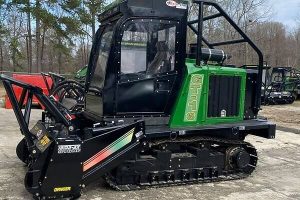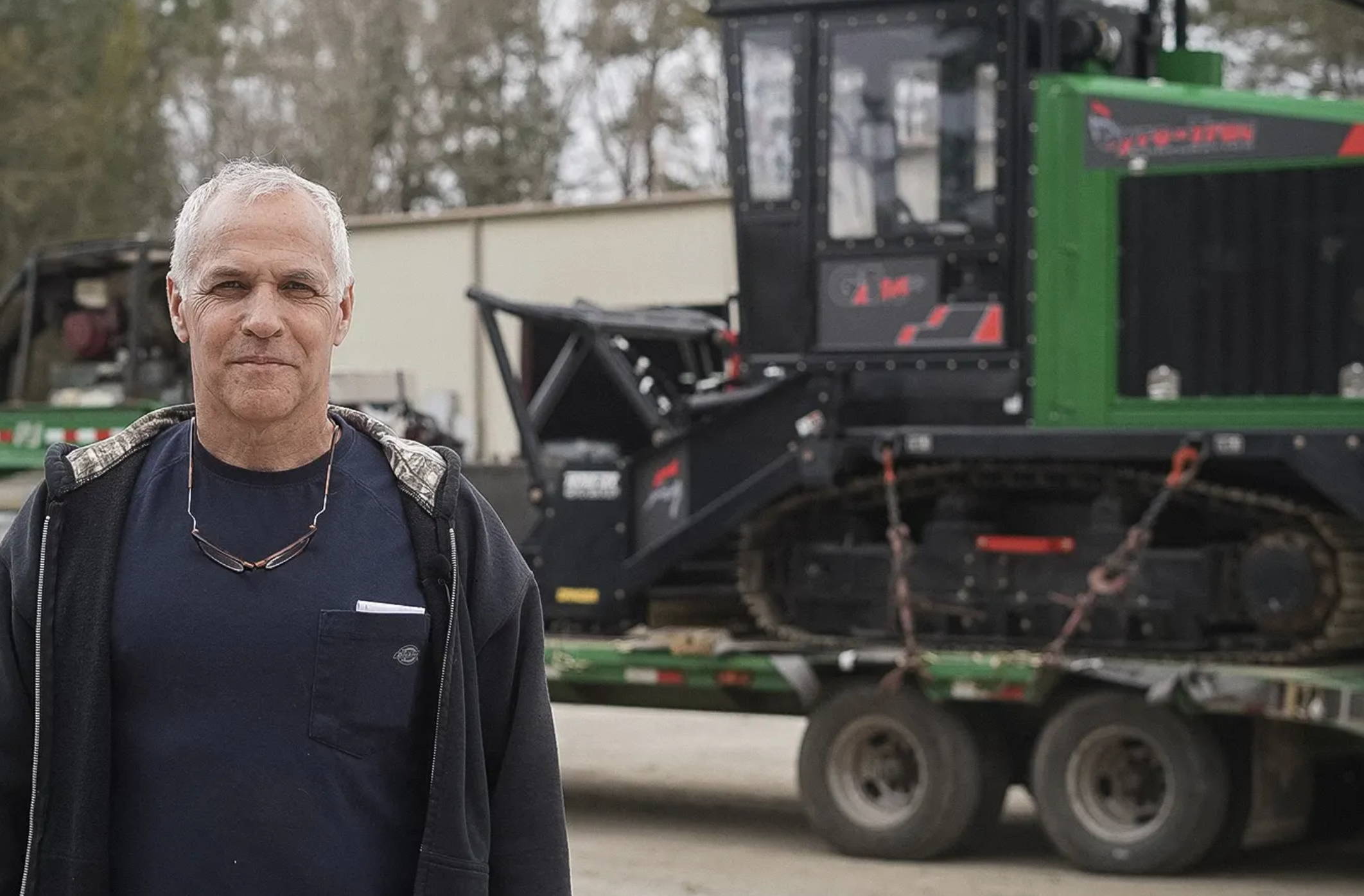Common Mini Excavator Questions
Today we are looking at the many frequently asked questions around the use and abilities of a mini excavator. Being involved in forestry work for so long has proved that almost any piece of machinery in the right hands can be extremely capable! So, don’t let the smaller size fool you, mini excavators get the job done, fit in tight spots, and are easy to transport.
Let’s answer some common mini excavator questions!
Can you remove a tree with a mini excavator?
With the right cutting head and/or mulcher attached to a mini excavator machine, it's more of a question of "What can't a mini excavator do?"
Some mini excavators are purpose-built for land clearing and forestry work, which are ideal for professionals who make their living in the industry. If you need more versatility with your mini excavator, then it's ideal to invest in a quality cutting head, mulcher, or combination of the two to help take down trees and brush.
Many of today's cutting and mulching heads are specifically designed to attach to mini excavators and track hoes to streamline productive land clearing work. They're lightweight, yet powerful enough to make short work of a tree that's up to 6 inches in diameter, mulching it into fine wood chips in a matter of seconds. Another nice thing about these attachments is that they can mulch trees into fine pieces, allowing professionals to reuse them for landscaping or package and sell them to retailers.
Can you clear land with a mini excavator?
We said it before and we'll say it again here. It's often not a question of "What can you do with a mini excavator?" It's more of a question of "What can't you do with a mini excavator?" Obviously, you'll need the right accessory attachments, but the nice thing about mini excavators as compared to heavy-duty equipment is that they're compact and more versatile. They can be outfitted with a variety of attachments and make land clearing a breeze in areas where a bigger piece of equipment wouldn't be able to access quite as easily.
For instance, in addition to open areas of land, mini excavators with the right mulching attachment can easily navigate into ditches, onto slopes, and even get close to roadsides. It's worth repeating that a mini excavator in land and brush clearing roles is only going to be as good as the attachments that it’s outfitted with. Noting this, it's just as important to ensure that the heads you attach to it are going to meet your land clearing needs and productivity goals. There are several options to choose from.
Can a mini excavator remove stumps?
As long as it's equipped with a mulching head capable of removing stumps, a mini excavator can absolutely take out a full stump — and the right mulching head won't just cut it clean on the surface either, but mulch several inches or even a few feet into the soil. You might not associate a mini excavator with being able to easily mulch away a tree stump, but with the right attachment, it can make relatively short work of even the peskiest ones.
What's nice about some of the leading cutting heads on the market today is that they feature advanced cutting head teeth technology that actually work to "self sharpen." This technology allows you to keep your equipment in the field longer, mulch better for longer, and save on labor costs and downtime. It's common for many in the forestry industry to spend at least one hour per day grinding and sharpening cutting head teeth. With self-sharpening teeth, head attachments can operate for up to 100 hours without the need for sharpening.
Can a mini excavator remove concrete?
Many of the FAQs so far on this list have largely focused on the forestry industry and the role that a mini excavator can play in mulching and land clearing. But make no mistake about it, mini excavators are very versatile and can accomplish a wide range of tasks. One of them just so happens to be concrete removal. Matt Weidner with Sharper Edge Custom Concrete, a concrete driveway installer explained that a mini excavator compact sized made it perfect for fitting through service yards and gates when working around residential property.
With the right equipment and the right attachments, mini excavators can saw, smash and remove concrete in no time flat. It's just one of the many tasks that mini excavators can help professionals accomplish.g attachment with a mini excavator?
Absolutely! Mini excavators are as versatile as they are compact, and one of the neat things about them is their ability to support a variety of attachments, including mulching attachments. What's more is that technology and innovation have seen such drastic improvements in attachment heads that there's now more than ever available to outfit your excavator with. Good mulching attachments fit quickly and easily and help take your tasks to a new level of efficiency, making them practical to boot.
How efficient and effective are mulching attachments designed for mini excavators? Many are able to mulch a tree with a 6-inch diameter into fine pieces in a matter of just minutes. Another nice thing about these attachments is that they can often produce fine mulch that can be repurposed for landscaping or packaged and sold to a retail store.
How deep can a mini excavator dig?
Depending on the type of mini excavator you're using, you'll likely be able to dig anywhere from 10 to 14 feet deep. Smaller mini excavators, such as those that weigh in the 4,000- to 6,000-pound range, can typically dig up to 10 feet into the ground. Larger mini excavators that fall into the 10,000- to 12,000-pound weight limits have the potential to dig even deeper, up to 14 feet. While using a mini excavator might not be the most efficient way to dig out a basement, for instance, it can be utilized for a lot of smaller and more select digging tasks, like footings.
Are mini excavators easy to use?
We're going to answer this question in a couple of different ways. First, we'll answer to their ease-of-use based on how these pieces of equipment are operated. Then, we'll answer the question based on how easy it is to attach and detach accessories.
In terms of operation, mini excavators are easier to drive than arguably ever before. And the good news is that unless you're operating an excavator on a public road, then you don't need any special type of license or certification to operate one. Users operate the mini excavator from the cab and use a variety of controls and levers to lower blades, dig, or throttle up the power. With a little bit of practice and some basic orientation, it's not difficult to get the hang of how to use a mini extractor quickly.
Mini excavators can also be outfitted with a variety of attachments, including cutters, mulching heads, and more. Like the excavators themselves, these attachments are more user-friendly than ever before and are able to be easily attached and detached from the machine. Many of the attachments are even lighter than they've ever been, which makes them all the easier to attach and detach. For instance, Gyro-Trac is known for having the lightest mulching head attachments in the industry.
Can anyone rent a mini excavator?
Mini excavators are able to rent on an hourly, daily, weekly, and monthly basis for those who need to complete one-off tasks or bigger projects. For professionals in forestry, landscaping, or other related industries, however, it often makes more sense to purchase a mini excavator outright — both from a financial perspective and in terms of being sure you have access to this equipment when you need it or when you want to use it. The average rental cost of a mini excavator ranges from $200 to $500 per day, a price that often includes drop-off and pick-up. It's common to receive a discount on the per-day rate for those who rent out excavators on a longer basis.
A big part of the mini excavator market is rentals. It's estimated that anywhere from 40 to 50 percent of mini excavators are rented by users for work purposes.
Can you dig footings with a mini excavator?
Footings are an important part of the foundation in construction. They often consist of concrete with rebar reinforcement, and they're placed into a hole or a trench that has been excavated. And this hole or trench is where a mini excavator can play a significant role. Remember, small mini excavators can dig up to 10 feet into the ground and larger mini excavators can dig up to 14 feet into the ground.
That's what makes them so ideal for digging footings, which are usually only dug about 1 meter, or 3.2 feet deep. Digging these trenches are well within the capabilities of a mini excavator, especially when you consider that their smaller overall nature allows them to maneuver into tighter spaces on construction sites more easily.
Can I use a mini excavator for right-of-way (ROW) clearing?
Right-of-way, or ROW, clearing is the practice of cutting and mowing some 15 feet away from a single-phase line and about 20 feet away from a three-phase line. It also involves clearing brush around pipelines and electrical stations. And to answer the question of if a mini excavator is ideal for this type of work, the answer is a resounding "yes!" Mini excavators can make quick work of brush clearing and mulching, taking out vegetation and trees in a matter of minutes if the right attachments are connected. Due to the versatility and functionality of mini excavators, there isn't a whole lot that they can't do.
Have you been researching mini excavators and the possible attachments they can handle? Let us know if you have more questions.



